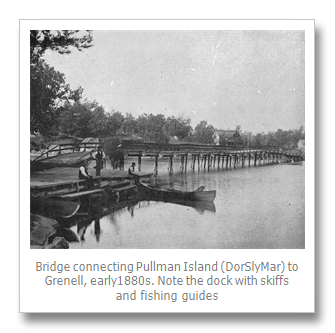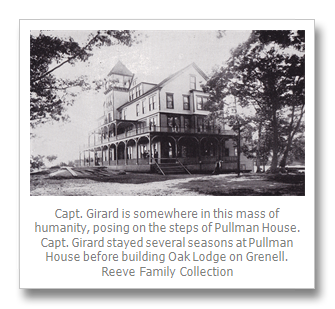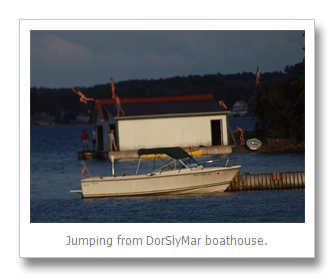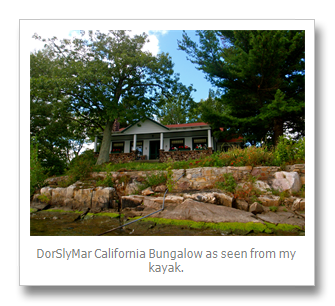For those of us who live at the foot of Grenell, Pullman Island is helpful for nighttime navigation. We depend on that red light on the boathouse on the north side of Pullman Island, to help find our way home after dark. Once upon a time, this little island was the south-eastern tip of Grenell. Long after it became a separate island, it was still considered part of Grenell. I think it would surprise most of us on Grenell that it was known as Pullman Island for only a decade and has technically been DorSlyMar Isle for over 80 years.
In the Story of Grenell, Olivia Pratt tells us that it was Sam and Lucy Grenell’s son, Myron, who had a hand in the creation of what we Grenellians think of as Pullman Island:
Myron and his friends, with their shovels, dug a little channel across the narrowest part of the point, and soon the winter storms and waves, washed away the sandy soil, until the little channel became what it is today [in 1948] a wide stretch of shallow water. Then, the point being an island, a bridge was built, a wide bridge for the old farm wagon and horse. It was built from the north west point of the little island, over to the grassy point, and could easily be seen from our cottage here. I don’t remember when the bridge was built, but it was there at my earliest recollection.

An 1897 newspaper article reports that the bridge was 150 ft. long. Looking at the few pictures of the era, I can tell there had been more than one bridge. Winter storms and/or ice damaged or totally removed the bridge many times and it had to be rebuilt often. But even though this point of land had been severed from Grenell, the .9-acre of land was still considered Grenell Island, perhaps because it was still connected by a bridge to the main island. Or maybe because this was the point of land where Sam and Lucy Grenell lived.
Sam and Lucy had a farm in the center of the main island. The southeast tip is where they built a long low house. They hung the sign “The Tavern” over the door. From what I’ve read, it was the graciousness of the hosts more than the elegance of the accommodations that attracted fisherman and travelers to the little tavern/inn. In 1875, my husband’s Great-Uncle, Otis Pratt, honeymooned at Grenell Tavern with his new bride, Alice.

In 1877, Sam and Lucy upgraded to a two-story structure that could accommodate as many as 40 people. They upgraded the name too. Now instead of “The Tavern,” the sign on the second-story veranda read “Grenell House.” After playing host to hunters, fisherman and excursionists for nearly 30 years, the Grenells decided to sell. In 1889, Sam and Lucy sold their small inn to J. I. Sayles of Rome and moved across the bridge to a new cottage built near their farm in the center of the island. Sayles moved the buildings to the backside of the island and in November of 1889 broke ground on a new grand hotel.
While Grenell House was a small, two-story affair, the new hotel was huge. It was 85 feet long and three stories tall with large verandas on the first two floors. Sayles decided to call it the Pullman House after George Pullman who brought notoriety to the Thousand Islands when he invited President U. S. Grant to his island downriver. Supposedly he used the name Pullman to evoke images of cutting edge design and comfort, but perhaps Sayles hoped the public would be confused and think that this is where the President had been entertained.

As you walked in the grand front door, there was a drawing room and a spacious dining room on the right, both with brick fireplaces. At times, the tables and chairs were removed from the dining room and it doubled as a ballroom. On the left side of the entryway was the office, a reading room, a smoking room, a bar room and a cloakroom. The kitchen and storeroom were also on the first floor. A large, wide staircase with double landings led upstairs. The second and third floor housed the sleeping rooms, 54 of them in all. An 1890 newspaper article described them as “large and pleasant and excellent views of the river may be had from all of them.” It went on to add, “The hotel is very tastily painted, the colors most used being a light bronze and canary. The doors are finished in cherry and mahogany. The trimmings are mostly red.” All the woodwork on the first floor had a natural finish. The woodwork on the second and third stories was painted white with hardwood flooring throughout.
The article also said, “Bathrooms furnished with hot and cold water are situated on each floor; also water closets and wash–rooms. A hot air pump forces water into a large tank in the attic, from which the hotel is supplied throughout.” But hot and cold running water wasn’t the only technological wonder. The office had an electric bell annunciator, meaning each room could ring the desk for assistance and someone would come scurrying to see what they wanted. Communication was also enhanced by speaking tubes in every hall of the building.
Outside were lawn tennis courts and croquet grounds. On the north side of the island, a dock was built for guests to use. The basement opened out onto a dock with “eight fine shellac boats, built by Joseph Leyare” of Clayton. Also on the north side of the island was the laundry and the barbershop.
The Pullman House was very popular in its early years as this 1897 Roman Semi-Weekly Citizen newspaper article attests:
Pullman House, Grenell Island, St. Lawrence River, Aug. 16.—Yesterday was a most delightful day here, the retreat for Romans, one of the most pleasant and most sightly spots on the majestic St. Lawrence river, the Venice of America. If there is a breeze anywhere on the river it may be enjoyed on this picturesque island. It is the third stopping place for all river steamers after leaving the Clayton dock, and is just across the channel from T. I. Park.
An 1891 article tells us that, “Guests at the Pullman House are coming in considerable numbers. Landlord Lewis has made large bookings and most of the guests at the Pullman stay from six weeks to two months. By Saturday there will be over fifty permanent guests.”
In 1893, the Pullman House had a new seawall of several hundred feet installed, which nearly doubled the available room on the island. That year the Pullman House also added a new bath house. At the urging of guests, W. P. Rogers, the current proprietor, built a “high water toboggan slide” near the side dock and underneath was the “Pullman House Natatorium,” a word of the day meaning indoor swimming pool. Not sure if there was really an indoor swimming pool there or not. The current indentation for the former basement of the Pullman House looks like the right size for a small swimming pool.
Toboggan slides were popping up all around the river in the 1890s. Thousand Island Park had one. They were like a giant kids slide, but with rollers. From the engravings I’ve seen, the “bathers” look like they are using a burlap bag or some sort of cloth that they carry with them as they climb the ladder and sit on before they slide down and splash into the water below. Some toboggan slides were 70 ft. long…I’m not sure how high. I can’t help wondering if the slide would have been visible from our point. Visible or not, I’m sure Uncle Otis and Aunt Alice would have been able to hear the screams and the splashes.
In 1895, a newspaper article announced, “Last season the Pullman House could not begin to accommodate its guests and so a large addition was built on.” Around 1897 the hotel was in need of a facelift. It was repainted white, and added a new 22 X 50 ft. dock and an electric light plant.
The hotel got another facelift in 1899. The Syracuse Post Standard reported that, “the exterior has been painted with an immaculate coat of white and presents a most attractive appearance. The interior has been entirely repapered and thoroughly renovated. The Pullman now ranks among the first-class hotels along the river and its large patronage attests to his popularity.”
It seems to have been a busy place with steamers, large and small arriving day and night. An 1895 Syracuse Daily Standard article describes it like this, “All the boats stop at the Pullman House dock and it is a fetching sight when the St. Lawrence, the Islander, or the new Empire State round in loaded with happy excursionists to make the landing.”
Fishing was the original draw not only to Pullman, but the entire region. Eel Bay was considered to be the best fishing on the river and was a short row away from Pullman House. Newspapers were full of fishing reports.
Syracuse Daily Standard, 1895:
Here is another catch of fish all caught before breakfast. The fisherman were all guests of the Pullman House, Grenell Island and the catch consisted of eight fine pickerel, each one of which weighed over four pounds and all were caught within two hours’ time. They were on exhibition on the Pullman House Lawn this morning and were admired by a large number of hotel guests.
Syracuse Daily Standard, 1897:
Life on Grenell Island is exceedingly bright these days. The Pullman House is well filled and every steamer leaves some new guests. Now that fishing has improved to such a marked degree, parties are organized nearly every day for excursions to the various bass and fishing grounds.
Syracuse Herald, 1899:
One of the most enthusiastic fishermen on the river is Capt. W. E. Girard, who is staying at the Pullman House. Late Thursday he brought in a magnificent catch of 21 pickerel, the largest one weighing 12 pounds and the rest averaging 4 pounds apiece.
Capt. Girard eventually built Oak Lodge in 1904 on the channel side of Grenell, where six generations have continued to enjoy fishing and boating in the St. Lawrence.
The Pullman House offered outstanding fishing by day and first-class entertainment at night. The hotel regularly hosted dances, which were called “full-dress balls” or “hops,” featuring live music from orchestras or bands. The popular dances of the day were the waltz and the two-step. Popular dance music included John Phillips Sousa selections such as The Bride Elect, Semper Fidelis and El Capitan.
There were numerous newspaper descriptions of evening entertainment at the Pullman House:
Syracuse Herald, 1890:
The full dress hops at the various hotels along the river to-night are the most elaborate of the season. Over at the Pullman House a hop is being had. Under the new management this hostlery is fast becoming a popular place.
Syracuse Daily Standard, 1896:
The hop given at the Pullman house Thursday was largely attended and it is needless to say that every one had an enjoyable time. A large party from Clayton chartered the Little Mac and were among the merrymakers.
Syracuse Daily Standard, 1897:Pullman House receipt. Kerr Family Collection
A great many people from the park visited the Pullman House last evening to listen to a band concert by the Lowville band, which is to be at the Pullman House for the entire week. A sacred concert was given this afternoon. The Pullman House is becoming one of the liveliest places on the river.
Syracuse Herald 1899:
A very fine literary entertainment was given last Thursday evening by the waiters of the Pullman House. The young men are all members of the graduating class of ’99 of the Cortland Normal School and expect to enter college in the fall. Several selections were rendered during the evening by the Susan Thompkins Harp Orchestra. About a hundred people were present at the entertainment and a pretty fair sum was realized by the young men.
Pullman House was owned by J. I. Sayles until his death in 1901, but passed to heirs, daughter, Josephine Irene Sayles, and son, General Sayles. It was run by a number of people: George C. Bedell, W. P. Rogers, David C. Lewis and finally at the end, Capt. E. G. Robbins. Pullman House seemed to flounder after Sayles died. A 1903 Rome Daily Sentinel article says “The first few years of its existence it proved a paying venture, but of late it has been run at a loss, while time and weather have played havoc.” The heirs had it for sale in 1903 for $20,000. And there were interested buyers.
The same 1903 Rome Daily Sentinel article goes into detail about a potential sale:
Friends of S. H. Vandergrift of Pittsburgh, who has a handsome summer home near there [Long Rock] have been looking over the property. They say that in case a sale is effected it is the intention to tear down the hotel and in its place build a beautiful summer home. The location is one of the most commanding on the river and would be an ideal site for a home. It is understood that Mr. Vandergrift is anxious to have his friends secure the place. Since he bought the island at the head of Grenell Island, several of his Pittsburgh friends have bought places nearby’', until now there is a small Pittsburgh colony.
Evidently, the sale did not go through. Pullman House, like so many hotels of the era, burned to the ground a year later. It was late in the season, September 10 and the last of the summer guests had just departed the day before. Mrs. Rich, who had a cottage at the foot of Grenell, was the first to smell smoke and hear the crackling of the flames at 2 in the morning. She woke everyone in the hotel: a cook, a carpenter and the proprietor, Capt. E. G. Robbins. The fire had started in a chimney of an old fireplace that had been used the day before for the first time in years. Thankfully, there was no wind that morning and the fire did not spread to the cottages at the foot of Grenell or into the yacht basin.
As far as I can tell, after the fire…the little island sat empty for nearly three decades. Perhaps now that there was no bridge connecting it to Grenell, the people on Grenell began to refer to it as Pullman Island.
In 1922, the little island that once held the grand Pullman House was purchased by Albert Gilman, who was described in a 1922 Watertown Daily times article as “one of the most prominent merchants in Rochester.” The same article went on to describe building of the Gilman cottage:
The house being built by Mr. Gilman is on the style of a California bungalow, being low and rambling in design. The entire front of the house is one immense room, equipped with fireplaces and usual comforts for lounging. Back of this room are the bed rooms and dining rooms and back of these are the kitchen and servants’ quarters. The rear of the house is built in the form of a huge enclosed plaza and will be used for sleeping purposes. Beside the house, Contractor Mitchell of Thousand Island Park is also erecting a dock and yacht house for the Rochester man. The place will be ready for occupancy by the first of next summer.
Ten years later…the house was sold to Dr. Alfonzo F. Brand and his wife Helen. The couple had three daughters Marilynn, Sylvia and Dorothy, who was born the same year as they purchased the island, 1933. The Brands renamed the island DorSlyMar for their three daughters. The elder Brands have passed on, but the island is shared by the three daughters and their families today. Each sister has her assigned month on the island. It was Dorothy’s month when I kayaked over. I was surprised to find a croquet court set up on the lawn at the foot of the island. Dorothy says they play croquet every night. She showed me the indentation where the basement that had opened onto the guest dock and where 8 shellacked skiffs waited to ferry guests to Eel Bay. Or perhaps this indentation was the Natatorium (indoor swimming pool.)

Dorothy also showed me a gash in the stone fireplace. She’d been told that the mark was caused by an ax wielded by an enraged husband from Grenell, who had just discovered that Mr. Gilman was having an affair with his wife. Dorothy told me the bathtub had been destroyed in the same incident. She asked if the story was true. I told her I didn’t know. I have not poked around asking questions of families on Grenell. Some skeletons should stay in their closets. But the incident might have prompted the sale to the Brands in 1933. The Brands have been quiet, unobtrusive neighbors for the last 81 years.

These days are much, much quieter. No steamships arriving hourly at the docks. No parade of fishing guides rowing guests to Eel Bay. No live bands playing music into the night. One afternoon last summer, a handful of kids jumped from the roof of the boathouse with screams of delight. It made me think of the toboggan slide. Still hard for me to fathom such a huge structure as Pullman House, with hundreds of guests, on such a tiny island. Actually, when we go by Pullman—or rather DorSlyMar— on evening boat rides, I see Dorothy and her grandchildren playing croquet at the foot of the island and wave. I guess some things on the river haven’t changed so much.
By Lynn E. McElfresh, Grenell Island
This is Lynn’s 66th article for TI Life… She is not only a regular contributor to TI Life, writing stories dealing with her favorite Grenell Island and island life, but Lynn and her husband Gary, continue to give us a special look at Island life in the past and just yesterday. When not on their beloved Grenell Island, they winter in Dunedin, Florida. See all of Lynn’s 60+ articles here.